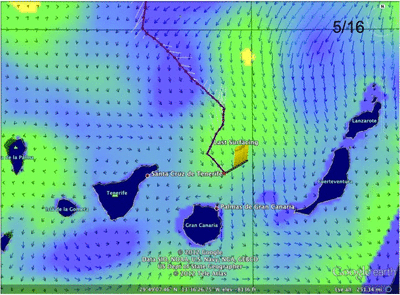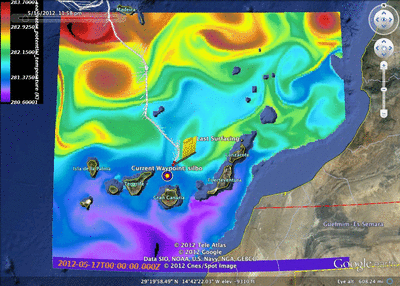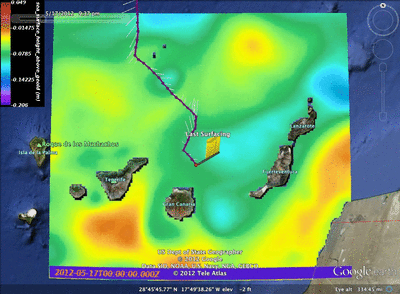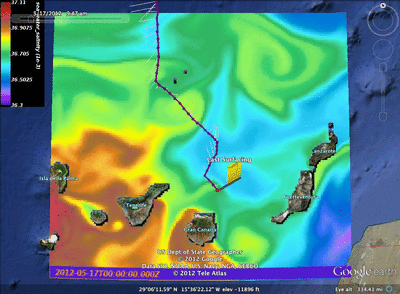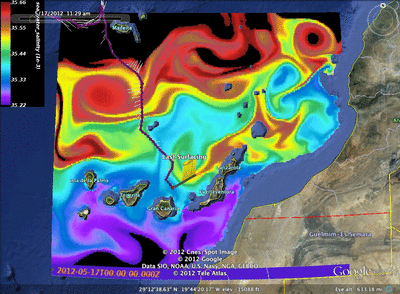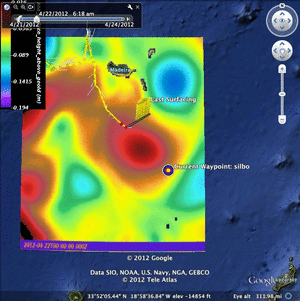Hey All,
So over the past couple days Antonio and I have been working on analyzing the biological growth that we found on Silbo upon recovery. This began with the analysis of growth on another epic glider mission which preceded Silbo’s : The Trans Atlantic Crossing of Ru27, The Scarlet Knight.
Scarlet was at sea for 221 days covering 7400km on her crossing from New Jersey to Spain. While on this journey, Scarlet became severely plagued by biological growth as populations of Goose neck barnacles latched on. This produced a large amount of drag, similar to the flaps being extended on an air plane’s wings for breaking, which resulted in Scarlet’s velocity being reduced to 10%. In the first image, we have a comparison between a time series of temperature across the Atlantic between NJ and Spain, compared with Scarlet’s velocity profiles.
In the velocity profiles, we see 3 distinct decreases in velocity, which when compared to temperature, we can conclude defines the presence of a new cohort’s existence.
The first cohort, which took hold pretty early on in the mission, took roughly 90 days to reduce the velocity to 10%.
On top of that, Scarlet then hit a strong heat signature which accelerated this decrease in velocity to nearly zero, leaving Scarlet to be nearly at the point of a drifter. This only took about 12 days, meaning a jump in the growth of the first cohort, or the uprising of a second. This resulted in an emergency excursion to the Azores by Rutgers technicians Chip and Tina where the barnacles were then washed off.
After Scarlet was cleaned off and returned to full throttle, a new cohort latched on, but at this point being out of the main branch of the Gulf Stream, the temperatures that fueled the growth were absent and it took the last 140 days of the mission to reduce Scarlet’s velocity once again.
From this information, Antonio applied the von Bertalanffy model to project our findings to apply to the growth we measured on Silbo upon recovery.
Another finding was that as long as the temperature is below 15˚C we will see no growth on the glider.
Combining what we had previously found, we then looked into the sizes of the barnacles found on Silbo compared with the temperatures along the way.
From the measurements we saw two cohorts, one about 8mm and one that was less than 2.
Then back tracking through Silbo’s mission to compare with the data and von Bertalanffy model, we concluded that the first cohort was from the very beginning of the mission while the second could only be about a few weeks old.
I then went back and plotted each dive from Silbo and found that at the beginning of the mission, Silbo spent about a day diving to 500m where the waters were relatively warm. Then on March 12, it looks like we had an abort which led to Silbo sitting at the surface for at least half of a day. This scenario mixed with warm temperatures and the productive waters associated with the islands led to conditions in which the barnacles were able to latch on and begin to grow.
Then later in the mission as Silbo was passing the island of Madeira, Silbo dropped a call and spent nearly a day sitting at the surface on May 4. Again in the presence of warm productive waters (provided by the island) we saw the presence of the second cohort
Looking to the future, the waters between Gran Canaria and Cape Verde are much warmer than we are seeing in teh crossing between Cape Verde and Brazil. This means that we will likely see a situation much like when Scarlet reached the Azores, and so a cleaning will most likely be needed by the time Silbo reaches Cape Verde. Then as we cross the equatorial counter current, we should not see any problems. As seen below, we can see that even though at the surface the equator is significantly warmer, by 200m the temperature plummets to a level which we believe will be safe for Silbo.
On a final note, Silbo’s new batteries will arrive soon and redeployment will likely follow soon after.
Force Wind Sea & Honor
Antonio Ramos & Nilsen Strandskov










































